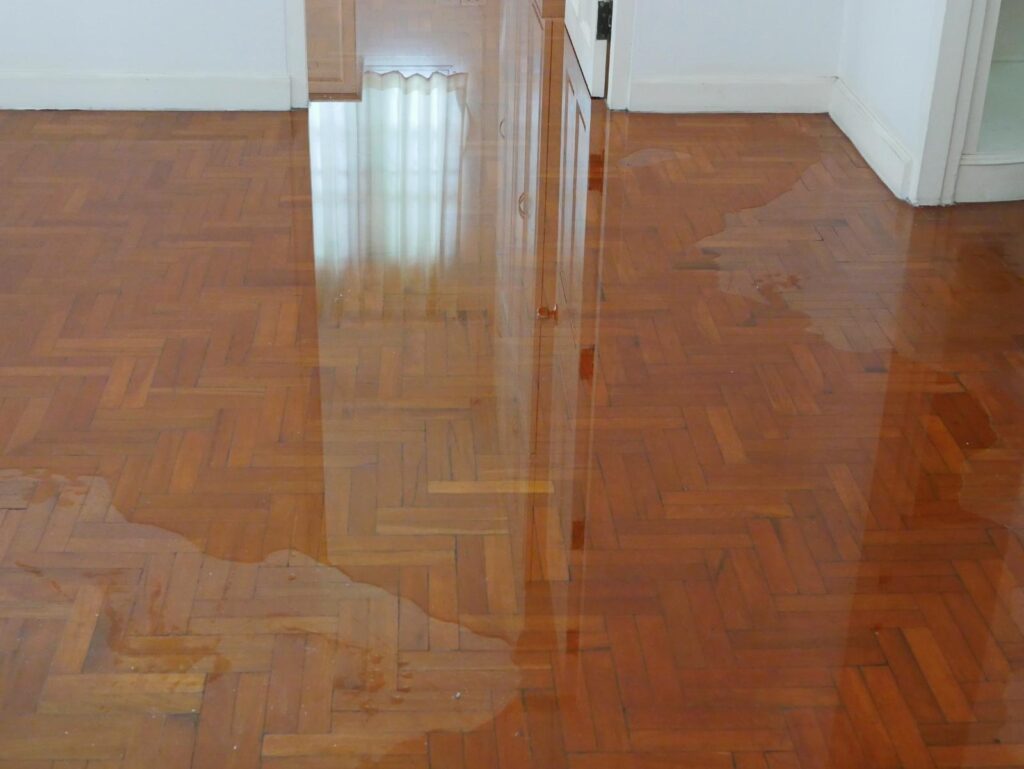
Contents
When faced with flood damage, it’s essential to approach the repair process systematically. Start by conducting a thorough assessment of the affected areas. This isn’t just a visual inspection; you’ll need to measure moisture levels to understand the full extent of the damage. Once you’ve gathered this information, you can move on to the next vital step. Let’s explore how to effectively remove standing water and prevent further complications.
Key Takeaways
- Conduct a thorough inspection to assess damage and document affected areas for insurance claims.
- Remove standing water using pumps and wet vacuums to prevent further damage.
- Use high-capacity fans and dehumidifiers to accelerate drying and monitor moisture levels.
- Clean and disinfect all affected surfaces with EPA-approved products to eliminate contaminants.
- Evaluate structural damage, replace compromised materials, and restore the area to prevent future issues.
Assessing the Damage
How do you determine the extent of flood damage to your property? Start by conducting a thorough visual inspection. Check for visible water lines on walls, floors, and furniture, noting the highest point reached.
Next, inspect structural elements like beams and joists for warping or rot. Use a moisture meter to assess hidden dampness in walls and flooring, as unseen moisture may lead to mold growth. Document any damaged items, including appliances and personal belongings, taking photos for insurance claims.
Pay attention to your electrical system; if water has reached outlets or wiring, it’s essential to consult a professional electrician.
Additionally, review your basement or crawl space for signs of flooding and damage. By systematically evaluating each area, you’ll gain a clear understanding of the damage’s extent, enabling you to make informed decisions for the next steps in recovery.
Water Removal and Extraction
After evaluating the damage, the next step is to begin water removal and extraction. This process is vital for preventing further harm to your property and reducing the risk of mold growth.
Follow these steps to guarantee effective water removal:
Assess the Water Level: Determine how much water is present, as this influences the extraction method you’ll use.
Gather Equipment: Use pumps, wet vacuums, and hoses to remove standing water efficiently.
Clear the Area: Move furniture and belongings to prevent additional damage and facilitate access to affected zones.
Check for Hidden Water: Inspect areas like basements and crawl spaces, as water often hides in these spots.
Drying and Dehumidification
Once you’ve successfully removed the standing water, drying and dehumidification become essential to restoring your property and preventing mold growth.
Begin by using high-capacity fans and dehumidifiers to accelerate the drying process. Position fans to create a cross-ventilation effect, guaranteeing air circulates throughout the affected areas. Set your dehumidifiers to maintain humidity levels below 50%—this is key in inhibiting mold spores from settling.
Check the moisture content in materials like drywall, wood, and carpets using a moisture meter; aim for levels below 15%. If certain materials remain damp, consider removing and replacing them to prevent future issues.
Continue monitoring the environment daily to guarantee ideal drying conditions.
Cleaning and Disinfection
As you move forward with the restoration process, cleaning and disinfection are critical to eliminate contaminants and prevent health hazards. Floodwaters can introduce harmful bacteria and pathogens into your environment.
Here’s a methodical approach to guarantee thorough cleaning:
Remove Debris: Clear out any solid waste, mud, or remnants from floodwaters to prepare for cleaning.
Use Appropriate Cleaners: Select EPA-approved disinfectants to effectively kill germs. Dilute according to instructions for maximum efficacy.
Scrub Surfaces: Employ brushes or cloths to scrub all affected surfaces thoroughly, guaranteeing you reach all crevices where contaminants may hide.
Rinse and Dry: After cleaning, rinse surfaces with clean water and allow them to dry completely to prevent mold growth.
Restoration and Repair
While cleaning and disinfection lay the groundwork for a safe environment, the restoration and repair process is where you begin to rebuild and restore your space to its pre-flood condition.
Start by evaluating structural damage; this includes checking for compromised beams, walls, and foundations. Document everything with photos for insurance purposes.
Next, remove any damaged materials like drywall or insulation. Once cleared, focus on drying your space thoroughly to prevent mold growth. Utilize dehumidifiers and fans to expedite this process.
After ensuring everything’s dry, it’s time for repairs. Replace damaged materials with new, high-quality substitutes. If flooring is affected, consider waterproof options for future resilience.
Don’t forget to check electrical and plumbing systems; consult professionals if needed.
Finally, apply finishes and paint, making your space feel like home again. This methodical approach not only restores your environment but also helps you reclaim your sense of belonging.
Final Thoughts
In summary, effectively addressing flood damage is vital for restoring your space. Did you know that nearly 90% of flood-related mold growth occurs within 48 hours of water exposure? By following these five essential steps—assessing the damage, removing water, drying the area, cleaning surfaces, and restoring structural integrity—you can greatly reduce the risk of long-term issues. Taking prompt action not only safeguards your property but also guarantees a healthier living environment for you and your loved ones.
Recent Posts
What Is the Step-by-Step Flood Damage Repair Process?
When you face flood damage, evaluating the damage, extracting water, and drying the area are
Comprehensive Guide to Flood Damage Repair Process
Flooding can devastate your property in ways you might not even imagine. To effectively tackle
Unlocking the Secrets of Water Extraction Tools
When tackling water extraction, understanding the tools at your disposal is essential. Each type of
